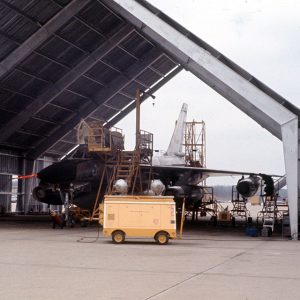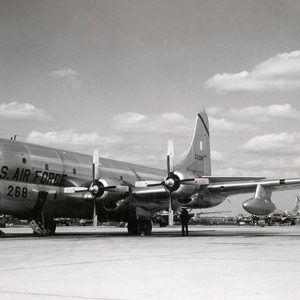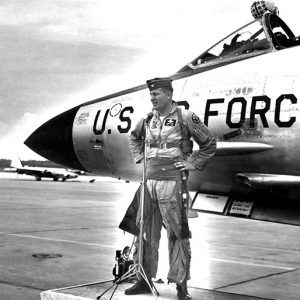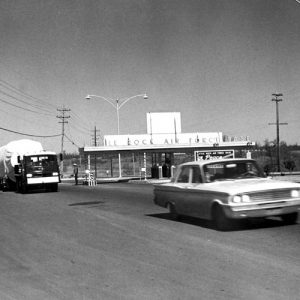calsfoundation@cals.org
Little Rock Air Force Base
The Little Rock Air Force Base (LRAFB) is located on 6,412 acres of land within the city limits of Jacksonville (Pulaski County). The base is a self-contained community that has contributed greatly to the economy and growth of the area since it became operational in 1955. The LRAFB is the largest C-130 base in the world.
In 1951, members of the Greater Little Rock Chamber of Commerce learned that the Air Force was considering locating a new base in the central United States but that Congress was not interested in purchasing land for the base because the United States already owned some World War II airfields that could be converted to active bases. Everett Tucker, manager of the Industrial Department of the chamber, Pulaski County Judge Archibald Campbell, Harry Pfeifer, and Ike Teague were among the leaders of the campaign to obtain an Air Force base for Pulaski County. An agreement reached with the Air Force held that funds would be raised by local groups to purchase the land for the Air Base, and a site near Jacksonville that included a portion of the World War II–era Arkansas Ordnance Plant (AOP) was selected for the new medium jet bomber base.
The Strategic Air Command (SAC) approved the master plan for the Air Base in January 1953, with a projected cost of $50,000,000, and the Pulaski County Citizens Council (PCCC), with Raymond Rebsamen as president and Arthur Phillips as fundraising chairman, spearheaded a campaign to raise between $650,000 and $800,000. Dr. Marcus Lafayette Harris, president of Philander Smith College, organized a fund raising drive in the Black business community with a goal of $10,000.
After World War II, most of the land occupied by the AOP had been resold to former owners or sold to businesses. Only a small part of the former AOP site belonged to the United States government in 1953. When this land was resold to former owners or sold to businesses, the United States had a “recapture” provision in the contracts, allowing the government to reclaim the land as needed.
The Army Corps of Engineers, Little Rock District Office, oversaw the construction of the base. On December 8, 1953, official groundbreaking ceremonies were held. By the time LRAFB was officially activated on October 9, 1955, 100 officers and 1,134 airmen were located at the base. An open house was held for the public, and approximately 85,000 people attended.
The base was home to the 825th Air Division, which was composed of the Seventieth Strategic Reconnaissance Wing (SRW) and the 384th Bombardment Wing (BW). The 384th BW did not arrive at the base until January 1956. With this wing came B-47E medium bombers. In 1956, the base was operating at only half capacity but was still awarded SAC “Base of the Year.”
The addition of the LRAFB provided employment opportunities to people in the central Arkansas area. It also provided more buyers for local products and more individuals to use services available in the area, in addition to bringing new businesses and services to the area. A community council that included airmen and Jacksonville residents was established immediately after the base was opened. The council was the first such organization in the country and, since being established, has been a model for other airbases.
On the morning of March 31, 1960, an Air Force B-47 engaged in a routine training flight exploded over the Pulaski Heights area of Little Rock, killing three airmen and two civilians. Debris from the aircraft damaged houses over a wide area, broke a water main, and ruptured a natural gas line; the released natural gas mixed with jet fuel and created a blaze that burned for several hours. Local residents helped to gather pieces of the plane for later investigation, and the Air Force posted guards around damaged home to prevent looting. A crash on November 12, 1971, at the base killed ten servicemen.
On June 22, 1960, the Air Force announced plans to establish eighteen Titan II missile launch sites near LRAFB. The 308thStrategic Missile Wing (SMW) was activated to man the silos. The first Titan II Inter-Continental Ballistic Missile (ICBM) was installed at launch site 373-4 in White County on February 28, 1963, and soon after that, ICBMs were installed at all eighteen central Arkansas sites.
The base has been home to many other Air Force groups, including the Forty-third Bomb Wing (BW), equipped with B-58 aircraft; the Seventieth Air Refueling Squadron, equipped with KC-97 tankers; and the 314th Tactical Airlift Wing. Since 1971, the 314th has been designated the host unit, which means that it functions as the overall command unit of the base, with all other units being designated tenant units. At different times, it has been under the command of the Tactical Airlift Command, Military Airlift Command, Air Mobility Command, and Air Combat Command. On April 1, 1997, the Airlift Wing (AW) transferred to the Air Education and Training Command (AETC). The focus of the wing is to train all C-130 aircraft crew members from all branches of the U.S. services, the U.S. Coast Guard, and students from twenty-eight allied nations.
The wing consists of a maintenance group, medical group, mission support group, and operations group. The 314th Operations Group is made up of four flying squadrons and one operational squadron. The Fifty-third and Sixty-second Airlift Squadrons fly training missions in C-130E and C-130H aircraft. The C-130s are tactical military transport aircraft. The Sixty-third Airlift Squadron was activated in December 2003 as a C-130J training unit. This model of the C-130 climbs faster and higher, flies farther at a higher cruise speed, and takes off and lands in a shorter distance than earlier models. The first active duty C-130J aircraft arrived at the LRAFB on March 19, 2004.
Also stationed at the base is the 189th Airlift Wing, Arkansas Air National Guard. The 189th AW has eighteen subordinate units and operates the C-130 Tactical Airlift Instructor School.
As world conditions have changed over the years, the mission of the LRAFB has changed to keep up with the needs of the United States. At no time has the base operated at reduced capacity, and it continues to be a dynamic force in the central Arkansas area and the world. The base plans air shows at least yearly to entertain the civilian population of Arkansas and demonstrate the capabilities of the United States Air Force.
The Little Rock Air Force Base’s economic impact statement for fiscal year 2022 stated that the base had $1.79 billion worth of economic impact, including with the employment of 6,498 military personnel and 1,202 civilians.
On June 25, 2021, Colonel Angela Ochoa became the first woman to assume command of LRAFB.
For additional information:
“60th Anniversary.” Special issue, Combat Airlifter, October 9, 2015.
Burford, Timothy, and Stephanie Burford. Heartland: The History of the Little Rock Air Force Base. Jacksonville, AR: Wirestorm Publishing, 2002.
Haddigan, Michael. “Up in the Air.” Arkansas Times, December 12, 1997, pp. 9–11
Hawkins, Wiliard A. “S.A.C. and the City.” Arkansas Gazette Sunday Magazine, October 7, 1956, p. 1F.
Jacksonville Museum of Military History. Jacksonville, Arkansas.
Little, Carolyn Yancey. Siftings from Jacksonville’s History, 1820 to 1980. Jacksonville, AR: Arkansas Sesquicentennial Committee, 1986.
Carolyn Yancey Kent
Jacksonville, Arkansas






































I met my husband when he was stationed at Little Rock Air Force Base in 1957-1958. I discovered this link and history today plus the fantastic on-base photos I cherish those in memory of Cecil C. Young. He was at the time a trained military photographer.